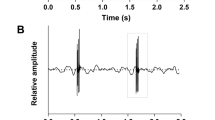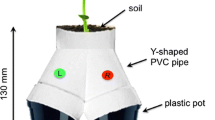Abstract
American water shrews (Sorex palustris) are aggressive predators that dive into streams and ponds to find prey at night. They do not use eyesight for capturing fish or for discriminating shapes. Instead they make use of vibrissae to detect and attack water movements generated by active prey and to detect the form of stationary prey. Tactile investigations are supplemented with underwater sniffing. This remarkable behavior consists of exhalation of air bubbles that spread onto objects and are then re-inhaled. Recordings for ultrasound both above and below water provide no evidence for echolocation or sonar, and presentation of electric fields and anatomical investigations provide no evidence for electroreception. Counts of myelinated fibers show by far the largest volume of sensory information comes from the trigeminal nerve compared to optic and cochlear nerves. This is in turn reflected in the organization of the water shrew’s neocortex, which contains two large somatosensory areas and much smaller visual and auditory areas. The shrew’s small brain with few cortical areas may allow exceptional speed in processing sensory information and producing motor output. Water shrews can accurately attack the source of a water disturbance in only 50 ms, perhaps outpacing any other mammalian predator.






Similar content being viewed by others
References
Albers KM, Perrone TN, Goodness TP, Jones ME, Green MA, Davis BM (1996) Cutaneous overexpression of NT-3 increases sensory and sympathetic neuron number and enhances touch dome and hair follicle innervation. J Cell Biol 134(2):487–497
Andres KH, von Düring M, Iggo A, Proske U (1991) The anatomy and fine-structure of the echidna tachyglossus-aculeatus snout with respect to its different trigeminal sensory receptors including the electroreceptors. Anat Embryol (Berl) 184(4):371–393
Anniko M, Arnesen AR (1988) Cochlear nerve topography and fiber spectrum in the pigmented mouse. Arch Otorhinolaryngol 245(3):155–159
Azzopardi P, Cowey A (1993) Preferential representation of the fovea in the primary visual-cortex. Nature 361(6414):719–721
Banfield AWF (1974) The mammals of Canada. University of Toronto Press, Toronto
Brecht M, Naumann R, Anjum F, Wolfe J, Munz M, Mende C, Roth-Alpermann C (2011) The neurobiology of etruscan shrew active touch. Proc Roy Soc B 366(1581):3026–3036
Catania KC (2000) Cortical organization in insectivora: the parallel evolution of the sensory periphery and the brain. Brain Behav Evol 55(6):311–321
Catania KC (2006) Olfaction: underwater ‘sniffing’ by semi-aquatic mammals. Nature 444(7122):1024–1025. doi:10.1038/4441024a
Catania KC (2009a) Symposium overview: underwater sniffing guides olfactory localization in semi aquatic mammals. Ann N Y Acad Sci 1170:407–412. doi:10.1111/j.1749-6632.2009.03925.x
Catania KC (2009b) Tentacled snakes turn C-starts to their advantage and predict future prey behavior. Proc Natl Acad Sci USA 106(27):11183–11187. doi:10.1073/pnas.0905183106
Catania KC, Kaas JH (1997) Somatosensory fovea in the star-nosed mole: behavioral use of the star in relation to innervation patterns and cortical representation. J Comp Neurol 387(2):215–233
Catania KC, Lyon DC, Mock OB, Kaas JH (1999) Cortical organization in shrews: evidence from five species. J Comp Neurol 410(1):55–72
Catania KC, Hare JF, Campbell KL (2008) Water shrews detect movement, shape, and smell to find prey underwater. Proc Natl Acad Sci USA 105(2):571–576. doi:10.1073/pnas.0709534104
Conaway CH (1952) Life history of the water shrew. Am Midl Nat 48(1):219–248
Czech-Damal NU, Liebschner A, Miersch L, Klauer G, Hanke FD, Marshall C, Dehnhardt G, Hanke W (2012) Electroreception in the Guiana dolphin (Sotalia guianensis). Proc Roy Soc B 279(1729):663–668. doi:10.1098/rspb.2011.1127
Dawkins R (1982) The extended phenotype. Oxford University Press, Oxford
Dehnhardt G, Hyvarinen H, Palviainen A, Klauer G (1999) Structure and innervation of the vibrissal follicle-sinus complex in the Australian water rat, Hydromys chrysogaster. J Comp Neurol 411(4):550–562
Ebner FF (1969) A comparison of primitive forebrain organization in metatherian and eutherian mammals. Ann N Y Acad Sci 167(A1):241–242
Estes JA (1989) Adaptations for aquatic living by carnivores. Cornell University Press, Ithaca
Fritzsch B, Wahnschaffe U (1983) The electroreceptive ampullary organs of urodeles. Cell Tissue Res 229(3):483–503
Gebo DL (2004) A shrew-sized origin for primates. Am J Phys Anthropol 40–62. doi:10.1002/Ajpa.20154
Glezer II, Jacobs MS, Morgane PJ (1988) The initial brain concept and its implications for brain evolution in cetacea. Behav Brain Sci 11(1):75–89
Glue DE (1970) Avian predator pellet analysis and the mammalogist. Mamm Rev 1(3):53–62. doi:10.1111/j.1365-2907.1970.tb00320.x
Gould E, Negus NC, Novick A (1964) Evidence for echolocation in shrews. J Exp Zool 156:19–37
Jablonski PG (2001) Sensory exploitation of prey: manipulation of the initial direction of prey escapes by a conspicuous ‘rare enemy’. Proc Roy Soc B 268(1471):1017–1022
Jablonski PG, McInerney C (2005) Prey escape direction is influenced by the pivoting displays of flush-pursuing birds. Ethology 111(4):381–396
Jablonski PG, Strausfeld NJ (2000) Exploitation of an ancient escape circuit by an avian predator: prey sensitivity to model predator display in the field. Brain Behav Evol 56(2):94–106
Jain N, Qi HX, Catania KC, Kaas JH (2001) Anatomic correlates of the face and oral cavity representations in the somatosensory cortical area 3b of monkeys. J Comp Neurol 429(3):455–468
Jeon CJ, Strettoi E, Masland RH (1998) The major cell populations of the mouse retina. J Neurosci 18(21):8936–8946
Kaas JH (1987) The organization of neocortex in mammals—implications for theories of brain-function. Annu Rev Psychol 38:129–151
Kaas JH (2000) Why is brain size so important: design problems and solutions as neocortex gets bigger or smaller. Brain Mind 1(1):7–23. doi:10.1023/a:1010028405318
Kaas J, Hall WC, Diamond IT (1970) Cortical visual areas I and II in hedgehog—relation between evoked potential maps and architectonic subdivisions. J Neurophysiol 33(5):595–615
Kepecs A, Uchida N, Mainen ZF (2006) The sniff as a unit of olfactory processing. Chem Senses 31(2):167–179. doi:10.1093/Chemsce/Bjj016
Kielan-Jaworowska Z, Cifelli RL, Luo ZX (2004) Mammals from the age of the dinosaurs: origins, evolution, and structure. Columbia University Press, New York
Leitch DB, Gauthier D, Sarko DK, Catania KC (2011) Chemoarchitecture of layer 4 isocortex in the American water shrew (Sorex palustris). Brain Behav Evol 78(4):261–271. doi:10.1159/000330832
Lende RA (1969) A comparative approach to neocortex -localization in monotremes, marsupials and insectivores. Ann N Y Acad Sci 167(A1):262–276
Michaloudi H, Dinopoulos A, Karamanlidis AN, Papadopoulos GC, Antonopoulos J (1988) Cortical and brain-stem projections to the spinal-cord of the hedgehog (Erinaceus-europaeus)—a horseradish-peroxidase study. Anat Embryol (Berl) 178(3):259–270
Naumann RK, Anjum F, Roth-Alpermann C, Brecht M (2012) Cytoarchitecture, areas, and neuron numbers of the etruscan shrew cortex. J Comp Neurol 520(11):2512–2530. doi:10.1002/Cne.23053
Nemec P, Cvekova P, Burda H, Benada O, Peichl L (2007) Visual systems and the role of vision in subterranean rodents: diversity of retinal properties and visual system designs. In: Begall S, Burda H, Schleich CE (eds) Subterranean rodents. Springer, New York, pp 128–160
Nudo RJ, Masterton RB (1990) Descending pathways to the spinal-cord. 3. Sites of origin of the corticospinal tract. J Comp Neurol 296(4):559–583
Pettigrew JD (1999) Electroreception in monotremes. J Exp Biol 202(10):1447–1454
Ramprashad F, Money KE, Landolt JP, Laufer J (1978) A neuroanatomical study of the cochlea of the little brown bat (Myotis lucifugus). J Comp Neurol 178(2):347–363. doi:10.1002/cne.901780209
Regidor J, Divac I (1992) Bilateral thalamocortical projection in hedgehogs—evolutionary implications. Brain Behav Evol 39(5):265–269
Repenning CA (1976) Adaptive evolution of sea lions and walruses. Syst Zool 25(4):375–390
Roman WG, MacArthur RA, Campbell KL (2012) Dive performance and aquatic thermoregulation of the world’s smallest mammalian diver, the American water shrew (Sorex palustris). Soc Exp Biol Abstracts A4.4:110
Rosa MGP, Krubitzer LA (1999) The evolution of visual cortex: where is V2? Trends Neurosci 22(6):242–248
Roth-Alpermann C, Anjum F, Naumann R, Brecht M (2010) Cortical organization in the etruscan shrew (Suncus etruscus). J Neurophysiol 104(5):2389–2406. doi:10.1152/Jn.00762.2009
Siemers BM, Schauermann G, Turni H, von Merten S (2009) Why do shrews twitter? Communication or simple echo-based orientation. Biol Lett 5(5):593–596. doi:10.1098/rsbl.2009.0378
Sorenson MW (1962) Some aspects of water shrew behavior. Am Nat 68:445–462
Stephan H, Baron G, Fons R (1984) Brains of soricidae. 2. Volume comparison of brain components. Zeitschrift Fur Zoologische Systematik Und Evolutionsforschung 22(4):328–342
Strait SG, Smith SC (2006) Elemental analysis of soricine enamel: pigmentation variation and distribution in molars of Blarina brevicauda. J Mammal 87(4):700–705
Suga N, Jen PHS (1976) Disproportionate tonotopic representation for processing Cf-Fm sonar signals in mustache bat auditory-cortex. Science 194(4264):542–544
Uchida N, Kepecs A, Mainen ZF (2006) Seeing at a glance, smelling in a whiff: rapid forms of perceptual decision making. Nat Rev Neurosci 7(6):485–491. doi:10.1038/nrn1933
Valverde F, Facalvalverde MV (1986) Neocortical layer-I and layer-II of the hedgehog (Erinaceus europaeus). 1. Intrinsic organization. Anat Embryol (Berl) 173(3):413–430
Welker WI (1964) Analysis of sniffing of the albino rat. Behaviour 22(3/4):223–244
Welker E, Van der Loos H (1986) Quantitative correlation between barrel-field size and the sensory innervation of the whiskerpad—a comparative-study in 6 strains of mice bred for different patterns of mystacial vibrissae. J Neurosci 6(11):3355–3373
Wieskotten S, Dehnhardt G, Mauck B, Miersch L, Hanke W (2010) Hydrodynamic determination of the moving direction of an artificial fin by a harbour seal (Phoca vitulina). J Exp Biol 213(Pt 13):2194–2200. doi:10.1242/jeb.041699
Williams RW, Strom RC, Rice DS, Goldowitz D (1996) Genetic and environmental control of variation in retinal ganglion cell number in mice. J Neurosci 16(22):7193–7205
Wong-Riley MT, Carroll EW (1984) Quantitative light and electron microscopic analysis of cytochrome oxidase-rich zones in V II prestriate cortex of the squirrel monkey. J Comp Neurol 222:18–37
Woolsey TA, Van der Loos H (1970) Structural organization of layer-Iv in somatosensory region (SI) of mouse cerebral cortex. Description of a cortical field composed of discrete cytoarchitectonic units. Brain Res 17(2):205
Author information
Authors and Affiliations
Corresponding author
Rights and permissions
About this article
Cite this article
Catania, K.C. The neurobiology and behavior of the American water shrew (Sorex palustris). J Comp Physiol A 199, 545–554 (2013). https://doi.org/10.1007/s00359-012-0781-7
Received:
Revised:
Accepted:
Published:
Issue Date:
DOI: https://doi.org/10.1007/s00359-012-0781-7




